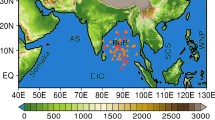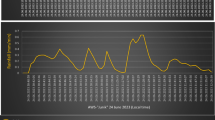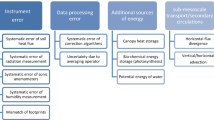Abstract
Differences in rainfall budgets between convective and stratiform regions of a torrential rainfall event were investigated using high-resolution simulation data produced by the Weather Research and Forecasting (WRF) model. The convective and stratiform regions were reasonably separated by the radar-based convective–stratiform partitioning method, and the three-dimensional WRF-based precipitation equation combining water vapor and hydrometeor budgets was further used to analyze the rainfall budgets. The results showed that the magnitude of precipitation budget processes in the convective region was one order larger than that in the stratiform region. In convective/stratiform updraft regions, precipitation was mainly from the contribution of moisture-related processes, with a small negative contribution from cloud-related processes. In convective/ stratiform downdraft regions, cloud-related processes played positive roles in precipitation, while moisture-related processes made a negative contribution. Moisture flux convergence played a dominant role in the moisture-related processes in convective or stratiform updraft regions, which was closely related to large-scale dynamics. Differences in cloud-related processes between convective and stratiform regions were more complex compared with those in moisture-related processes. Both liquid- and ice-phase microphysical processes were strong in convective/stratiform updraft regions, and ice-phase processes were dominant in convective/stratiform downdraft regions. There was strong net latent heating within almost the whole troposphere in updraft regions, especially in the convective updraft region, while the net latent heating (cooling) mainly existed above (below) the zero-layer in convective/stratiform downdraft regions.
概要
本文使用WRF模式对一次暴雨过程的高分辨率模拟资料研究了对流区和层状区降水收支过程的差异. 基于雷达反射率的对流-层状分类方法合理地识别出对流区和层状区. 进一步使用基于WRF模式并结合了水汽收支和云水凝物收支的降水收支方程对降水过程进行分析. 结果表明, 对流区降水收支过程要比层状区的大一个量级; 在对流/层状上升区, 降水主要来自水汽相关过程的正贡献和云相关过程弱的负贡献; 在对流/层状下沉区, 云相关过程对降水起到正作用, 而水汽相关过程是负贡献; 在对流/层状上升区, 水汽通量辐合在水汽相关过程中起到主导作用, 这与大尺度运动密切相关; 对流和层状区的云相关过程差异比水汽相关过程的更加复杂; 在对流/层状上升区, 液相和冰相微物理过程强度相当, 而在对流/层状下沉区则以冰相过程为主导; 在对流/层状上升区, 净潜热加热在整个对流层都很强, 尤其在对流上升区, 而在对流/层状下沉区, 净潜热加热(冷却)主要位于零度层之上(下).
Similar content being viewed by others
References
Ahmed, F., and C. Schumacher, 2015: Convective and stratiform components of the precipitation-moisture relationship. Geophys. Res. Lett., 42, 10 453–10 462, https://doi.org/10.1002/2015gl066957.
Bringi, V. N., L. Tolstoy, M. Thurai, and W. A. Petersen, 2015: Estimation of spatial correlation of drop size distribution parameters and rain rate using NASA’s S-band polarimetric radar and 2D video disdrometer network: Two case studies from MC3E. Journal of Hydrometeorology, 16, 1207–1221, https://doi.org/10.1175/JHM-D-14-0204.1.
Choudhury, A. D., and R. Krishnan, 2011: Dynamical response of the south Asian Monsoon trough to latent heating from stratiform and convective precipitation. J. Atmos. Sci., 68, 1347–1363, https://doi.org/10.1175/2011JAS3705.1.
Churchill, D. D., and R. A. Houze Jr., 1984: Mesoscale updraft magnitude and cloud-ice content deduced from the ice budget of the stratiform region of a tropical cloud cluster. J. Atmos. Sci. 41, 1717–1725, https://doi.org/10.1175/1520-0469(1984)041<1717:mumaci>2.0.co;2.
Cui, X. P., 2008: A cloud-resolving modeling study of diurnal variations of tropical convective and stratiform rainfall. J. Geophys. Res. Atmos., 113, D02113, https://doi.org/10.1029/2007jd008990.
Cui, X. P., 2009: Quantitative diagnostic analysis of surface rainfall processes by surface rainfall equation. Chinese Journal of Atmospheric Sciences, 33, 375–387, https://doi.org/10.3878/j.issn.1006-9895.2009.02.15. (in Chinese with English abstract)
Cui, X. P., and X. F. Li, 2006: Role of surface evaporation in surface rainfall processes. J. Geophys. Res. Atmos., 111, D17112, https://doi.org/10.1029/2005jd006876.
Cui, X. P., and X. F. Li, 2009: Diurnal responses of tropical convective and stratiform rainfall to diurnally varying sea surface temperature. Meteor. Atmos. Phys., 104, 53–61, https://doi.org/10.1007/s00703-008-0016-1.
Cui, X. P., and X. F. Li, 2011: A cloud-resolving modeling study of short-term surface rainfall processes. Meteor. Atmos. Phys. 111, 1–11, https://doi.org/10.1007/s00703-010-0121-9.
Cui, X. P., Y. S. Zhou, and X. F. Li, 2007: Cloud microphysical properties in tropical convective and stratiform regions. Meteor. Atmos. Phys., 98, 1–11, https://doi.org/10.1007/s00703-006-0228-1.
Feng, Z., X. Q. Dong, B. K. Xi, C. Schumacher, P. Minnis, and M. Khaiyer, 2011: Top-of-atmosphere radiation budget of convective core/stratiform rain and anvil clouds from deep convective systems. J. Geophys. Res. Atmos., 116, D23202, https://doi.org/10.1029/2011JD016451.
Gamache, J. F., 1990: Microphysical observations in summer MONEX convective and stratiform clouds. Mon. Wea. Rev., 118, 1238–1249, https://doi.org/10.1175/1520-0493(1990)118<1238:MOISMC>2.0.CO;2.
Gao, S. T., and X. F. Li, 2010: Precipitation equations and their applications to the analysis of diurnal variation of tropical oceanic rainfall. J. Geophys. Res. Atmos., 115, D08204, https://doi.org/10.1029/2009jd012452.
Gao, S. T., X. P. Cui, Y. S. Zhou, and X. F. Li, 2005: Surface rainfall processes as simulated in a cloud-resolving model. J. Geophys. Res. Atmos., 110, D10202, https://doi.org/10.1029/2004jd005467.
Gao, S. T., X. P. Cui, and X. F. Li, 2009: A modeling study of diurnal rainfall variations during the 21-day period of TOGA COARE. Adv. Atmos. Sci., 26, 895–905, https://doi.org/10.1007/s00376-009-8123-6.
Grim, J. A., G. M. McFarquhar, R. M. Rauber, A. M. Smith, and B. F. Jewett, 2009: Microphysical and thermodynamic structure and evolution of the trailing stratiform regions of mesoscale convective systems during BAMEX. Part II: Column model simulations. Mon. Wea. Rev., 137, 1186–1205. https://doi.org/10.1175/2008MWR2505.1.
Houze, R. A., Jr., 1977: Structure and dynamics of a tropical squall-line system. Mon. Wea. Rev., 105, 1540–1567. https://doi.org/10.1175/1520-0493(1977)105<1540:SADOAT>2.0.CO;2.
Houze, R. A., Jr., 1982: Cloud clusters and large-scale vertical motions in the tropics. J. Meteor. Soc. Japan, 60, 396–410, https://doi.org/10.2151/jmsj1965.60.1396.
Houze, R. A., Jr., 1989: Observed structure of mesoscale convective systems and implications for large-scale heating. Quart. J. Roy. Meteor. Soc., 115, 425–461, https://doi.org/10.1002/qj.49711548702.
Houze, R. A., Jr., 1997: Stratiform precipitation in regions of convection: A meteorological paradox? Bull. Amer. Meteor. Soc., 78, 2179–2196, https://doi.org/10.1175/1520-0477(1997)078<2179:SPIROC>2.0.CO;2.
Houze, R. A., Jr., 2014: Cloud Dynamics. 2nd ed. Academic Press, 496 pp.
Huang, Y. J., and X. P. Cui, 2015a: Dominant cloud microphysical processes of a torrential rainfall event in Sichuan, China. Adv. Atmos. Sci., 32, 389–400, https://doi.org/10.1007/s00376-014-4066-7.
Huang, Y. J., and X. P. Cui, 2015b: Moisture sources of torrential rainfall events in the Sichuan basin of China during summers of 2009–13. Journal of Hydrometeorology, 16, 1906–1917, https://doi.org/10.1175/jhm-d-14-0220.1.
Huang, Y. J., X. P. Cui, and Y. P. Wang, 2016a: Cloud micro physical differences with precipitation intensity in a torrential rainfall event in Sichuan, China. Atmospheric and Oceanic Science Letters, 9, 90–98, https://doi.org/10.1080/16742834.2016.1139436.
Huang, Y. J, X. P. Cui, and X. F. Li, 2016b: A three-dimensional WRF-based precipitation equation and its application in the analysis of roles of surface evaporation in a torrential rainfall event. Atmospheric Research, 169, 54–64, https://doi.org/10.1016/j.atmosres.2015.09.026.
Huang, Y. J., and Coauthors, 2018: Forecasting severe convective storms with WRF-based RTFDDA radar data assimilation in Guangdong, China. Atmospheric Research, 209, 131–143, https://doi.org/10.1016/j.atmosres.2018.03.010.
Kumar, V. V., A. Protat, C. Jakob, C. R. Williams, S. Rauniyar, G. L. Stephens, and P. T. May, 2016: The estimation of convective mass flux from radar reflectivities. Journal of Applied Meteorology and Climatology, 55, 1239–1257, https://doi.org/10.1175/JAMC-D-15-0193.1.
Li, Q., X. P. Cui, and J. Cao, 2014: Observational analysis and numerical simulation of a heavy rainfall event in Sichuan Province. Chinese Journal of Atmospheric Sciences, 38, 1095–1108, https://doi.org/10.3878/j.issn.1006-9895.1401.13255.
Li, X. F., 2006: Cloud microphysical and precipitation responses to a large-scale forcing in the tropical deep convective regime. Meteor. Atmos. Phys., 94, 87–102, https://doi.org/10.1007/s00703-005-0172-5.
Luo, Y. L., Y. J. Wang, H. Y. Wang, Y. J. Zheng, and H. Morrison, 2010: Modeling convective-stratiform precipitation processes on a Mei-Yu front with the Weather Research and Forecasting model: Comparison with observations and sensitivity to cloud microphysics parameterizations. J. Geophys. Res. Atmos., 115, D18117, https://doi.org/10.1029/2010jd013873.
Milbrandt, J. A., and M. K. Yau, 2005a: A multimoment bulk microphysics parameterization. Part I: Analysis of the role of the spectral shape parameter. J. Atmos. Sci., 62, 3051–3064, https://doi.org/10.1175/Jas3534.1.
Milbrandt, J. A., and M. K. Yau, 2005b: A multimoment bulk microphysics parameterization. Part II: A proposed three-moment closure and scheme description. J. Atmos. Sci., 62, 3065–3081, https://doi.org/10.1175/Jas3535.1.
Milbrandt, J. A., M. K. Yau, J. Mailhot, S. Bélair, and R. McTaggart-Cowan, 2010: Simulation of an orographic precipitation event during IMPROVE-2. Part II: Sensitivity to the number of moments in the bulk microphysics scheme. Mon. Wea. Rev., 138, 625–642, https://doi.org/10.1175/2009MWR3121.1.
Morrison, H., G. Thompson, and V. Tatarskii, 2009: Impact of cloud microphysics on the development of trailing stratiform precipitation in a simulated squall line: Comparison of oneand two-moment schemes. Mon. Wea. Rev., 137, 991–1007, https://doi.org/10.1175/2008mwr2556.1.
Mrowiec, A. A., C. Rio, A. M. Fridlind, A. S. Ackerman, A. D. Del Genio, O. M. Pauluis, A. C. Varble, and J. W. Fan, 2012: Analysis of cloud-resolving simulations of a tropical mesoscale convective system observed during TWP-ICE: Vertical fluxes and draft properties in convective and stratiform regions. J. Geophys. Res. Atmos., 117, D19201, https://doi.org/10.1029/2012JD017759.
Niu, S. J., X. C. Jia, J. R. Sang, X. L. Liu, C. S. Lu, and Y. G. Liu, 2010: Distributions of raindrop sizes and fall velocities in a semiarid plateau climate: Convective versus stratiform rains. Journal of Applied Meteorology and Climatology, 49, 632–645, https://doi.org/10.1175/2009JAMC2208.1.
Penide, G., V. V. Kumar, A. Protat, and P. T. May, 2013: Statistics of drop size distribution parameters and rain rates for stratiform and convective precipitation during the North Australian Wet Season. Mon. Wea. Rev., 141, 3222–3237, https://doi.org/10.1175/mwr-d-12-00262.1.
Rapp, A. D., A. G. Peterson, O. W. Frauenfeld, S. M. Quiring, and E. B. Roark, 2014: Climatology of storm characteristics in Costa Rica using the TRMM precipitation radar. Journal of Hydrometeorology, 15, 2615–2633, https://doi.org/10.1175/JHM-D-13-0174.1.
Romatschke, U., and R. A. Houze, Jr., 2011: Characteristics of precipitating convective systems in the South Asian Monsoon. Journal of Hydrometeorology, 12, 3–26, https://doi.org/10.1175/2010JHM1289.1.
Rulfová, Z., and J. Kyselý, 2013: Disaggregating convective and stratiform precipitation from station weather data. Atmospheric Research, 134, 100–115. https://doi.org/10.1016/j.atmosres.2013.07.015.
Sharma, S., M. Konwar, D. K. Sarma, M. C. R. Kalapureddy, and A. R. Jain, 2009: Characteristics of rain integral parameters during tropical convective, transition, and stratiform rain at Gadanki and its application in rain retrieval. Journal of Applied Meteorology and Climatology, 48, 1245–1266, https://doi.org/10.1175/2008JAMC1948.1.
Shen, X. Y., Y. Wang, and X. F. Li, 2011: Effects of vertical wind shear and cloud radiative processes on responses of rainfall to the large-scale forcing during pre-summer heavy rainfall over southern China. Quart. J. Roy. Meteor. Soc., 137, 236–249, https://doi.org/10.1002/qj.735.
Steiner, M., R. A. Houze Jr., and S. E. Yuter, 1995: Climatological characterization of three-dimensional storm structure from operational radar and rain gauge data. J. Appl. Meteor., 34, 1978–2007, https://doi.org/10.1175/1520-0450(1995)034<1978:ccotds>2.0.co;2.
Sui, C. H., K. M. Lau, W. K. Tao, and J. Simpson, 1994: The tropical water and energy cycles in a cumulus ensemble model. Part I: Equilibrium climate. J. Atmos. Sci., 51, 711–728, https://doi.org/10.1175/1520-0469(1994)051<0711:Ttwaec>2.0.Co;2.
Sui, C. H., C. T. Tsay, and X. F. Li, 2007: Convective-stratiform rainfall separation by cloud content. J. Geophys. Res. Atmos., 112, D14213, https://doi.org/10.1029/2006jd008082.
Tao, W.-K., J. Simpson, C. H. Sui, B. Ferrier, S. Lang, J. Scala, M. D. Chou, and K. Pickering, 1993: Heating, moisture, and water budgets of tropical and midlatitude squall lines: Comparisons and sensitivity to longwave radiation. J. Atmos. Sci., 50, 673–690, https://doi.org/10.1175/1520-0469(1993)050<0673:HMAWBO>2.0.CO;2.
Tao, W.-K., S. Lang, J. Simpson, W. S. Olson, D. Johnson, B. Ferrier, C. Kummerow, and R. Adler, 2000: Vertical profiles of latent heat release and their retrieval for TOGA COARE convective systems using a cloud resolving model, SSM/I, and ship-borne radar data. J. Meteor. Soc. Japan, 78, 333–355, https://doi.org/10.1175/1520-0450(2001)040<0957:RVPOLH>2.0.CO;2.
Tao, W.-K., S. Lang, X. P. Zeng, S. Shige, and Y. Takayabu, 2010: Relating convective and stratiform rain to latent heating. J. Climate 23, 1874–1893, https://doi.org/10.1175/2009jcli3278.1.
Tao, W.-K., Coauthors, 2001: Retrieved vertical profiles of la tent heat release using TRMM rainfall products for February 1998. J. Appl. Meteor., 40, 957–982, https://doi.org/10.1175/1520-0450(2001)040<0957:RVPOLH>2.0.CO;2.
Thurai, M., P. N. Gatlin, and V. N. Bringi, 2016: Separating stratiform and convective rain types based on the drop size distribution characteristics using 2D video disdrometer data. Atmospheric Research., 169, 416–423, https://doi.org/10.1016/j.atmosres.2015.04.011.
Wang, D. H., X. F. Li, and W.-K. Tao, 2010: Cloud radiative effects on responses of rainfall to large-scale forcing during a landfall of severe tropical storm Bilis (2006). Atmospheric Research, 98, 512–525, https://doi.org/10.1016/j.atmosres.2010.08.020.
Wang, J. J., X. F. Li, and L. D. Carey, 2007: Evolution, structure, cloud microphysical, and surface rainfall processes of monsoon convection during the South China Sea monsoon experiment. J. Atmos. Sci., 64, 360–380, https://doi.org/10.1175/jas3852.1.
Wu, D., X. Q. Dong, B. K. Xi, Z. Feng, A. Kennedy, G. Mullendore, M. Gilmore, and W. K. Tao, 2013: Impacts of microphysical scheme on convective and stratiform characteristics in two high precipitation squall line events. J. Geophys. Res. Atmos., 118, 11 119–111 135, https://doi.org/10.1002/jgrd.50798.
Xu, K. M., 1995: Partitioning mass, heat, and moisture budgets of explicitly simulated cumulus ensembles into convective and stratiform components. J. Atmos. Sci., 52, 551–573, https://doi.org/10.1175/1520-0469(1995)052<0551:Pmhamb>2.0.Co;2.
Yang, S., and E. A. Smith, 2000: Vertical structure and transient behavior of convective-stratiform heating in TOGA COARE from combined satellite-sounding analysis. J. Appl. Meteor., 39, 1491–1513, https://doi.org/10.1175/1520-0450 (2000)039<1491:VSATBO>2.0.CO;2.
Yang, Y., X. Chen, and Y. C. Qi, 2013: Classification of convective/stratiform echoes in radar reflectivity observations using a fuzzy logic algorithm. J. Geophys. Res. Atmos., 118, 1896–1905, https://doi.org/10.1002/jgrd.50214.
Yuter, S. E., and R. A. Houze Jr., 1995: Three-dimensional kinematic and microphysical evolution of Florida cumulonimbus. Part II: Frequency distributions of vertical velocity, reflectivity, and differential reflectivity. Mon. Wea. Rev., 123, 1941–1963, https://doi.org/10.1175/1520-0493(1995)123<1941:TDKAME>2.0.CO;2.
Zipser, E. J., 1977: Mesoscale and convective–scale downdrafts as distinct components of squall-line structure. Mon. Wea. Rev., 105, 1568–1589, https://doi.org/10.1175/1520-0493(1977)105<1568:MACDAD>2.0.CO;2.
Acknowledgements
This work was supported by the Strategic Priority Research Program of the Chinese Academy of Sciences (Grant No. XDA23090101), the Key Research Program of the Chinese Academy of Sciences (Grant No. KZZD-EW-05-01), and the National Basic Research Program of China (973 Program) (Grant No. 2015CB452804). This work was carried out at the National Supercomputer Center in Tianjin, and the calculations were performed using TianHe-1(A).
Author information
Authors and Affiliations
Corresponding author
Additional information
Article Highlights
• Precipitation budget processes in the convective region were one order of magnitude larger than those in the stratiform region.
• Moisture-related processes mainly contributed to precipitation in updraft regions, while cloud-related processes dominated in downdraft regions.
• Both liquid- and ice-phase microphysical processes were strong in updraft regions, and ice-phase processes were dominant in downdraft regions.
Rights and permissions
About this article
Cite this article
Huang, Y., Wang, Y. & Cui, X. Differences between Convective and Stratiform Precipitation Budgets in a Torrential Rainfall Event. Adv. Atmos. Sci. 36, 495–509 (2019). https://doi.org/10.1007/s00376-019-8159-1
Received:
Revised:
Accepted:
Published:
Issue Date:
DOI: https://doi.org/10.1007/s00376-019-8159-1




